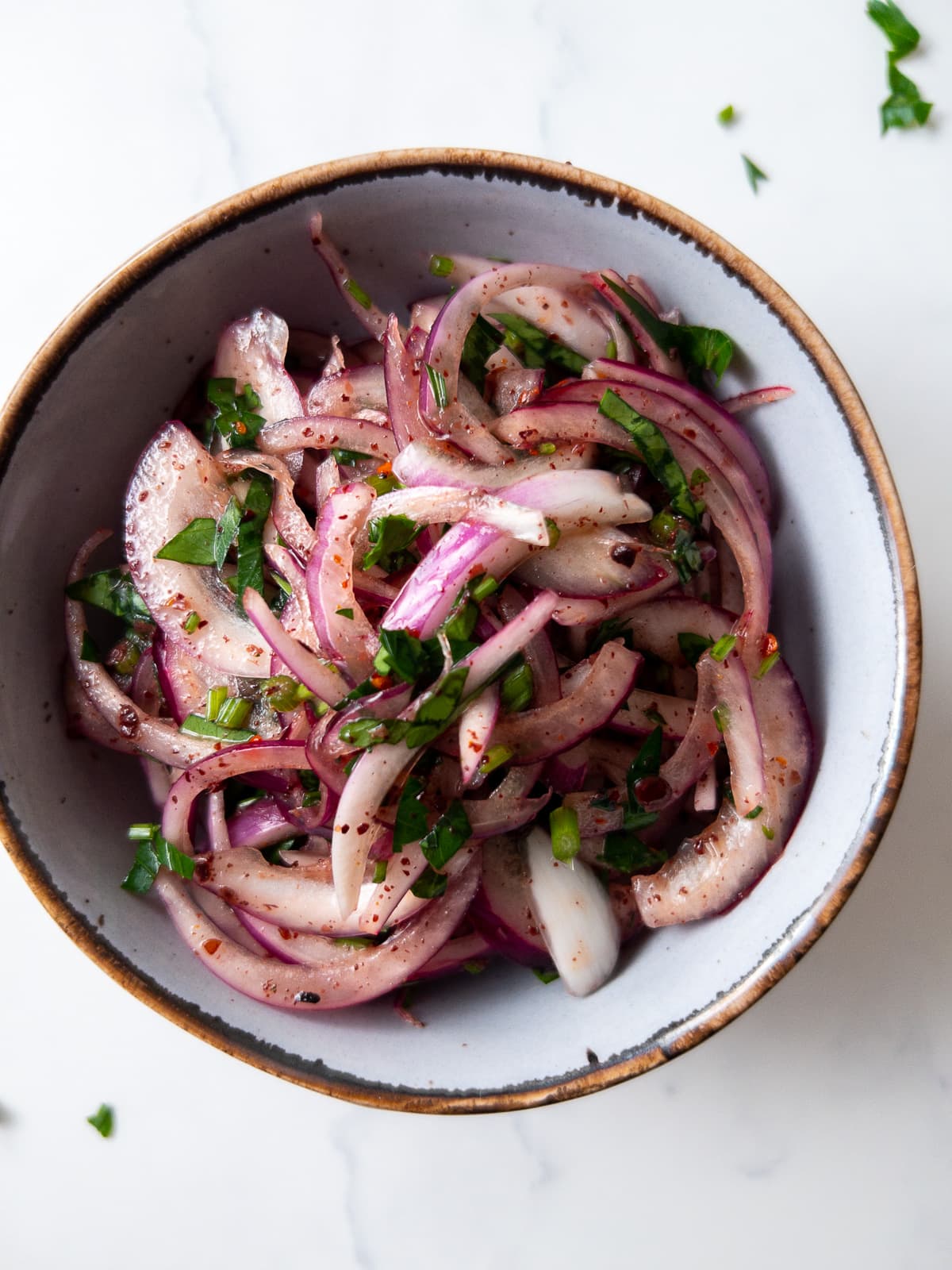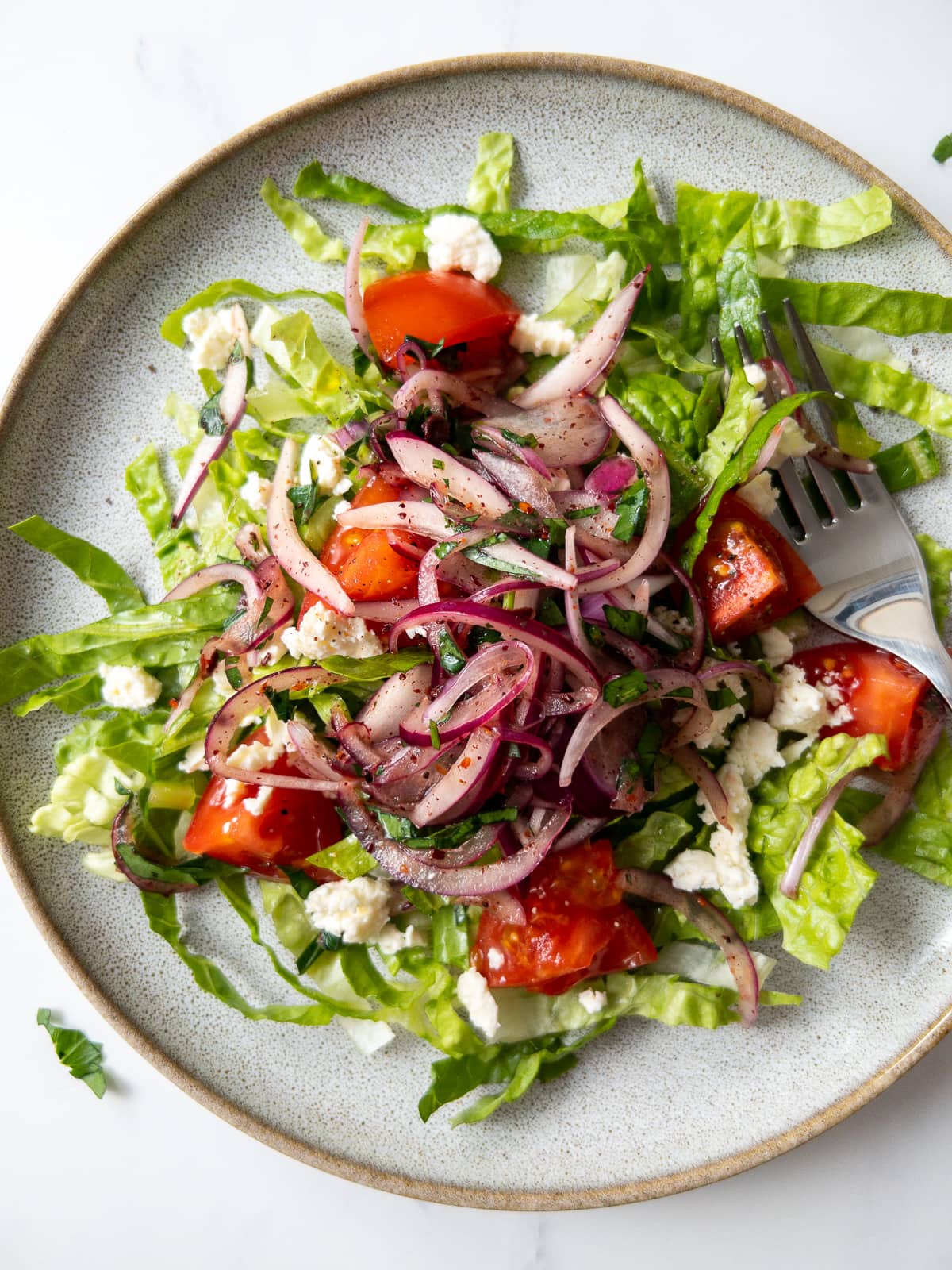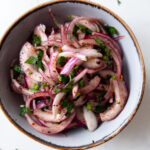Sumac onions are a classic part of many Middle Eastern salads and dishes. They are tangy, flavorful, and super simple to make!

If you love pickled onions, you need to give these sumac onions a try! They combine aromatic red onions, sweet and tangy pomegranate molasses, fresh parsley, flavorful red chili flakes, and citrusy sumac.
They are a favorite on salads, as part of a bowl, or in a wrap with delicious falafel. Plus, they are super simple to make and ready in only 5 minutes!
What are sumac onions?
If you’ve never heard of sumac onions, you might be wondering what they are and how they taste.
Sumac is a spice that is commonly used in many Middle Eastern countries. It is produced by grinding the dried berries of the sumac plant that grows in the Middle East. You can recognize sumac by the deep red and purple color of the spice.
The great thing about sumac is that it lends dishes an acidic and earthy flavor without being too pungent or sour. Lemons or vinegar are a lot sourer than sumac.
Sumac onions are usually made by adding sumac to thinly sliced onions. Other ingredients, such as parsley or red chili flakes, are often added for some extra flavor and usually vary between countries and regions.
This recipe for sumac onions is how they are typically prepared in Turkey. The recipe is heavy in sumac and parsley, two ingredients that are often used in Turkish recipes.
Sumac onions are traditionally used as a topping for your side salad alongside delicious kebab. But you can use these onions for any type of salad, bowl, or wrap!

Ingredients
To make sumac onions, you’ll need the following ingredients:
- Red onions: Red onions are often used to make sumac onions. Make sure to use medium-sized onions that aren’t too big. Otherwise, the ratios in this recipe will be off.
- Sumac: Sumac can be found in most Arab grocery stores. It has a deep red/purple color and has a similar texture and shape as chili flakes.
- Parsley: Another key ingredient is fresh parsley. So don’t forget to use it!
- Red chili flakes: As for chili flakes, I recommend using pul biber/aleppo pepper. The name you’ll find on the package varies with origin but both are the same. If you find pul biber with different heat levels, I recommend choosing „tatli“ as it is not as spicy as „aci“ pul biber.
- Pomegranate molasses: Pomegranate molasses is great for adding some extra acidity and a hint of sweetness. You can find it in any Arab grocery store. Lemon juice can be used as a replacement but keep in mind that both taste very different.
How to make sumac onions
Preparing sumac onions is so easy that you probably don’t even need instructions. Nevertheless, here they are:
- Prepare the ingredients: Cut the onions in half and then into thin slices. Finely chop the parsley.
- Combine: Add all ingredients to a bowl. Then toss until everything is combined.
- Serve: Serve the sumac onions as a topping for your salad. Enjoy!
Tips & Notes
Making sumac onions is really easy but I’d still recommend reading through the following notes to make sure that they turn out delicious!
- Don’t add any salt. If you add salt to the onions, it will dehydrate them. So you will end up with a small pool of water at the bottom of your bowl that contains all of your seasonings and dressing. Plus, the onions become very soft. Using only sumac will soften the onions enough while keeping most of the moisture inside. If you still want to use salt, I’d recommend adding it in the beginning. Then drain the water and rinse the onions before adding the other ingredients. I always skip the salt and add it to my salad right before serving.
- Cut the onion into thin slices. Onions have quite a strong taste, so cutting them into fine slices allows you to enjoy smaller pieces. Thinner slices also soften better, so make sure to use a sharp knife to finely slice the onions.
- Adjust the amount of parsley and red chili flakes. The amount of parsley and red chili flakes really is a matter of taste. I used quite a bit of both as this is how Turkish sumac onions are typically made. But feel free to use less!

Variations
I already mentioned that there are regional differences in how sumac onions are prepared. This recipe is typical of how they are prepared in Turkey. My family absolutely loves this recipe, but you might have different preferences.
So if you want to modify the recipe, here are a few classic ways to do it.
- Use some lemon juice. Other recipes use lemon juice to make sumac onions. It’s not a total necessity in this recipe as the pomegranate molasses and sumac already add acidity. But if you want to add some extra lemon juice after tasting the sumac onions, feel free to use some! I like to prepare some lemon wedges to serve alongside salads with sumac onions, but you can definitely add lemon juice directly to the onions. Depending on how I intend to serve the sumac onions, I will sometimes replace the pomegranate molasses with lemon juice.
- Dehydrate the onions. If you love very soft and more pickle-style onions, you can add some salt to the onions to remove some of the onions’ water. Then drain the water and rinse the onions before adding all of the other ingredients. This step isn’t necessary if you like onions that are only slightly softened with some crunch. Just do what makes you happy!
- Use white onions or yellow onions. Red onions are super delicious, but white onions or yellow onions work just as great in this sumac onions recipe! They all have a different flavor, so feel free to pick the one you like most.
How to serve sumac onions
Sumac onions are often served as part of a side salad alongside kebab but there are many other ways to enjoy them! Here are a few of my favorites:
- Bowls: I love to make Greek-style chicken bowls that are made with rice, chicken, salad, sumac onions, feta cheese, and tzatziki. They taste really good and are super easy to make!
- Lahmacun: Unfortunately, I don’t have a lahmacun recipe on this website yet. But sumac onions are perfect for filling delicious lahmacun. You can either buy them pre-made or make your own at home. Make sure to drizzle some lemon juice on top of the onions and enjoy!
- Fish sandwich: A Turkish street food that tastes great with lots of onions is fish sandwiches („balik ekmek“). They are usually made with baguette, seared fish filets (like branzino), plenty of sumac onions (in this case I’d use lemon juice instead of pomegranate molasses), and other vegetables like lettuce and tomatoes. It’s really simple but one of my favorite foods to enjoy whenever I am in Turkey.
- Wraps and pita bread: Another option is free-styling delicious wraps or pita bread! I love to make them with baked falafel, some hummus, vegetables, sumac onions, and a simple sauce made with yogurt and mayo. They are really good and super easy to make!
Frequently Asked Questions
The only spicy ingredient is red chili flakes. So if you are unsure about the chili flakes in this recipe, feel free to use less and add more as needed!
Unfortunately, no other spice tastes like sumac. So if you want to try this recipe, I’d highly recommend buying it in an Arab grocery store or ordering it online.
You can store leftovers in an airtight container in your refrigerator for a few days.

Other quick and delicious salad recipes
I am a huge fan of simple salad recipes that taste great! Here are some of my favorites that you might want to check out.
- Cabbage Kidney Bean Salad
- Greek Orzo Salad
- Italian Pasta Salad
- Mediterranean Chickpea Salad
- Kisir (Turkish Bulgur Salad)

Sumac Onions
Ingredients
- 2 medium-sized red onions peeled, halved, and cut into thin slices
- 3 tablespoons finely chopped parsley
- 1 tablespoon sumac
- 1 teaspoon red chili flakes recommended: aleppo pepper/pul biber
- 1 ½ tablespoon pomegranate molasses
Instructions
- Add all ingredients to a bowl. Then toss until everything is combined.
- Serve the sumac onions immediately or let them sit for 20 minutes to allow them to pickle and soften.
Notes
- Depending on your preferences and how you want to serve the sumac onions, you can use lemon juice instead of pomegranate molasses. Or simply serve your meal with a lemon wedge.




Leave a Reply